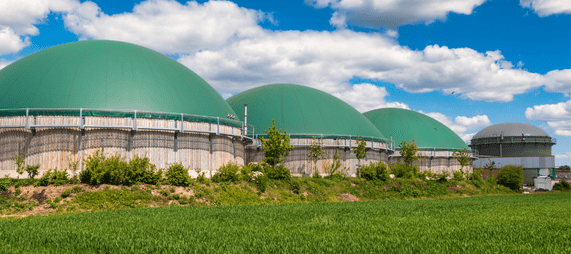Anaerobic Digestion Plant Design
Anaerobic Digestion plants can be designed and engineered to optimise production in a range of configurations. They are categorised into batch or continuous production, mesophilic or thermophilic temperature conditions, high or low solids and single or multi-stage process.
Batch processing tends to require a less complex design but requires more infrastructure and larger volume of digesters. Greater heat energy is required in a thermophilic system (48-60c) in comparison to mesophilic digestion (20-42c). Thermophilic digestion has a shorter time to production and higher methane content. Low solids content can contain around 15% solids, anything above that is considered high solids content and know as dry digestion. In single stage processing the 4 stages happen in one tank or digester. A multiple stage processes separates the Hydrolosis and Methanogenesis stages.
In batch processing materials are added to the digester then sealed for the duration of the process. It requires some adding of bacteria to start the process, like growing a culture in a petri dish. This produces a normalised pattern of biogas yield over time. Odour control in batch processing can be more difficult so is sometimes integrated with in-vessel composting.
In continuous processing, organic materials are continually added to the digester. This results in continual production of biogas. Single or multiple digesters can be used. There are several types of reactor used according to the resource materials that the anaerobic digestion plant was designed for.
Digesters are generally either continuous vertical plug flow or batch tunnel horizontal digesters. Continuous vertical plug flow digesters are upright, cylindrical tanks where feedstock is continuously fed into the top of the digester. Batch tunnel digesters, the feedstock is deposited in tunnel-like chambers with a gas-tight door. Contaminant removal depends on the nature of the waste streams (feedstock) being processed and the required quality of the digestate. Size reduction (grinding) is beneficial in continuous vertical systems, as it accelerates digestion. Batch systems avoid grinding and instead require structure (e.g. yard waste) to reduce compaction of the stacked pile.
Optimum Temperature for Anaerobic Digestion
The two conventional optimal operational temperatures for anaerobic digestion are Mesophilic digestion, which takes place between 30c to 38c. At ambient temperatures between 20c and 45c. Thermophilic digestion takes place between 49c to 57c. Temperatures can be increased to 70c.
Mesophilic systems are considered to be more stable than Thermophilic systems. This is due to the number of Mesophiles, which are more tolerant to environmental conditions. The majority of digesters globally are mesophilic systems.
Thermophilic systems are considered less stable with higher energy inputs yet higher biogas yields in less time. Higher temperatures deliver faster reaction rates and pathogen reduction of materials. This is necessary where Animal By-Products legislation governs the input of this type of materials and use of digestate back to agriculture.
Anaerobic Digestion Feedstock (Organic Waste Materials)
The most important aspect of Anaerobic Digestion is the organic Feedstock. Many types of organic materials can be used in the anaerobic digestion process. As biogas is the main objective of production the more digestible the better the biogas yield.
Feedstocks can include organic wate materials such as paper, grass, food, sewage and animal waste. Wastes with high wood content do not degrade due to lignin and require pretreatment before further degradation. Digesters can also be fed with energy crops as codigestion or cofermentation usually located on-farm.
Anaerobic Digesters were originally designed for use with sewage sludge and manure. However, this is not the most digestible type of material with the greatest calorific value. This type of organic material has already had much of the energy taken from it by the animals that produced it. So, in order to produce higher yields in this type of digestion there are often multiple feedstocks mixed with manure such as grass, corn, animal by products, grease, fats, oils and household food waste, creating a greater calorific value and therefore higher gas yield.
Moisture levels in feedstock also have an impact on production. Drier materials are more suited to horizontal or tunnel chambers, which have a very low rate of water discharge. The wetter the material the more readily it can be pumped however, this takes up area and volume relative to gas produced. High solids can be used to dilute wetter feedstocks. A carbon to nitrogen ratio level also needs to be assessed as this can have an impact on gas production.
Anaerobic Digestion Feedstock Contamination
If the feedstock has significant levels of material contamination such as glass, plastic or metals then this has to removed. Contaminants to feedstock can seriously affect machinery and equipment used to process the materials. There are also a number of legislative requirements in relation to the levels of contaminant in the feedstock as once processed goes back to land as digestate. The higher the level of contaminant the greater pretreatment is required increasing costs of the digestion process. If the feedstock load is highly contaminated then the feedstock maybe incinerated.





